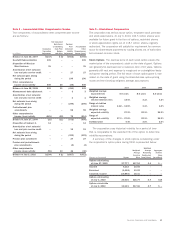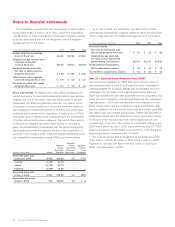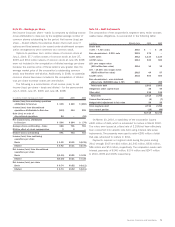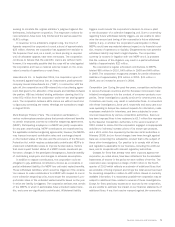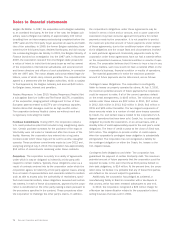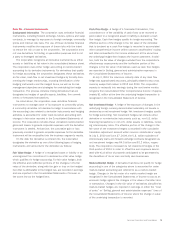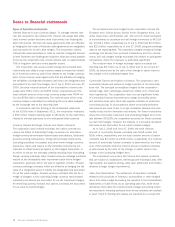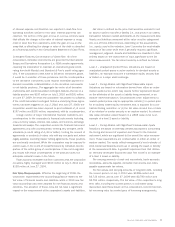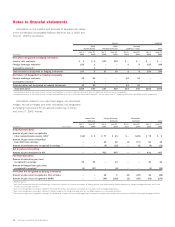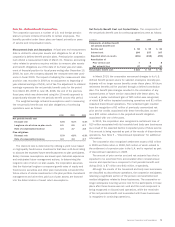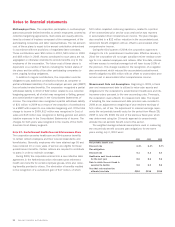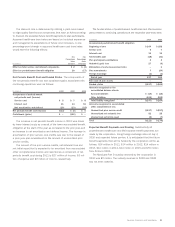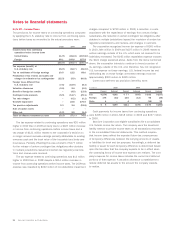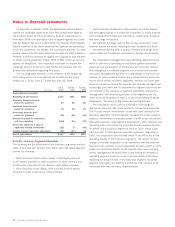Sara Lee 2010 Annual Report Download - page 78
Download and view the complete annual report
Please find page 78 of the 2010 Sara Lee annual report below. You can navigate through the pages in the report by either clicking on the pages listed below, or by using the keyword search tool below to find specific information within the annual report.Notes to financial statements
Types of Derivative Instruments
Interest Rate and Cross Currency Swaps
To manage interest rate
risk, the corporation has entered into interest rate swaps that effec-
tively convert certain fixed-rate debt instruments into floating-rate
debt instruments. Interest rate swap agreements that are effective
at hedging the fair value of fixed-rate debt agreements are designated
and accounted for as fair value hedges. The corporation utilizes
interest rate swap derivatives in order to maintain a targeted amount
of both fixed-rate and floating-rate long term debt and notes payable.
Currently, the corporation has a fixed interest rate on approximately
70% of long-term debt and notes payable issued.
The corporation has issued certain foreign-denominated debt
instruments and utilizes cross currency swaps to reduce the variabil-
ity of functional currency cash flows related to the foreign currency
debt. Cross currency swap agreements that are effective at hedging
the variability of foreign-denominated cash flows are designated and
accounted for as cash flow hedges. As of July 3, 2010 and June 27,
2009, the total notional amount of the corporation’s interest rate
swaps were $761 million and $385 million, respectively and the
total notional amount of the cross currency swaps were $704 mil-
lion and $786 million, respectively. The notional value of the cross
currency swaps is calculated by multiplying the euro value swapped
by the exchange rate at the reporting date.
In connection with the funding of the anticipated retirement
of the 6.25% notes in September 2011, the corporation maintains
a $50 million forward starting swap to effectively fix the cash flows
related to interest payments on the anticipated debt issuance.
Currency Forward Exchange, Futures and Option Contracts
The corporation uses forward exchange and option contracts to
reduce the effect of fluctuating foreign currencies on short-term
foreign-currency-denominated intercompany transactions, third-party
product-sourcing transactions, foreign-denominated investments
(including subsidiary net assets) and other known foreign currency
exposures. Gains and losses on the derivative instruments are
intended to offset losses and gains on the hedged transaction in
an effort to reduce the earnings volatility resulting from fluctuating
foreign currency exchange rates. Forward currency exchange contracts
mature at the anticipated cash requirement date of the hedged
transaction, generally within one year to eighteen months. Forward
currency exchange contracts which are effective at hedging the fair
value of a recognized asset or liability are designated and accounted
for as fair value hedges. Forward currency contracts that act as a
hedge of changes in the underlying foreign currency denominated
subsidiary net assets are accounted for as net investment hedges.
All remaining currency forward and options contracts are accounted
for as mark-to-market hedges.
The principal currencies hedged by the corporation include the
European euro, British pound, Danish krone, Hungarian forint, U.S.
dollar, Swiss franc and Brazilian real. The net U.S. dollar equivalent
of commitments to purchase and sell foreign currencies is $4.2 bil-
lion and $4.1 billion, respectively as of July 3, 2010 and $2.3 billion
and $2.2 billion, respectively as of June 27, 2009, using the exchange
rates at the reporting date. The corporation hedges virtually all foreign
exchange risk derived from recorded transactions and firm commit-
ments and only hedges foreign exchange risk related to anticipated
transactions where the exposure is potentially significant.
The notional value of foreign exchange option contracts out-
standing was $9 million as of July 3, 2010 and nil as of June 27,
2009, as determined by the ratio of the change in option value to
the change in the underlying hedged item.
Commodity Futures and Options Contracts
The corporation uses
commodity futures and options to hedge a portion of its commodity
price risk. The principal commodities hedged by the corporation
include hogs, beef, natural gas, diesel fuel, coffee, corn, wheat and
other ingredients. The corporation does not use significant levels
of commodity financial instruments to hedge commodity prices
and primarily relies upon fixed rate supplier contracts to determine
commodity pricing. In circumstances where commodity-derivative
instruments are used, there is a high correlation between the com-
modity costs and the derivative instruments. For those instruments
where the commodity instrument and underlying hedged item corre-
late between 80-125%, the corporation accounts for those contracts
as cash flow hedges. However, the majority of commodity derivative
instruments are accounted for as mark-to-market hedges.
As of July 3, 2010 and June 27, 2009, the total notional
amount of commodity futures contracts was $169 million and
$150 million, respectively, and the total notional amount of option
contracts was $3 million and $16 million, respectively. The notional
amount of commodity futures contracts is determined by the initial
cost of the contracts while the notional amount of options contracts
is determined by the ratio of the change in option value to the
change in the underlying hedged item.
The corporation only enters into futures and options contracts
that are traded on established, well-recognized exchanges that offer
high liquidity, transparent pricing, daily cash settlement and collater-
alization through margin requirements.
Cash Flow Presentation
The settlement of derivative contracts
related to the purchase of inventory, commodities or other hedged
items that utilize hedge accounting are reported in the Consolidated
Statements of Cash Flows as an operating cash flow, while those
derivatives that utilize the mark-to-market hedge accounting model
are reported in investing activities when those contracts are realized
in cash. Fixed to floating rate swaps are reported as a component
76 Sara Lee Corporation and Subsidiaries





